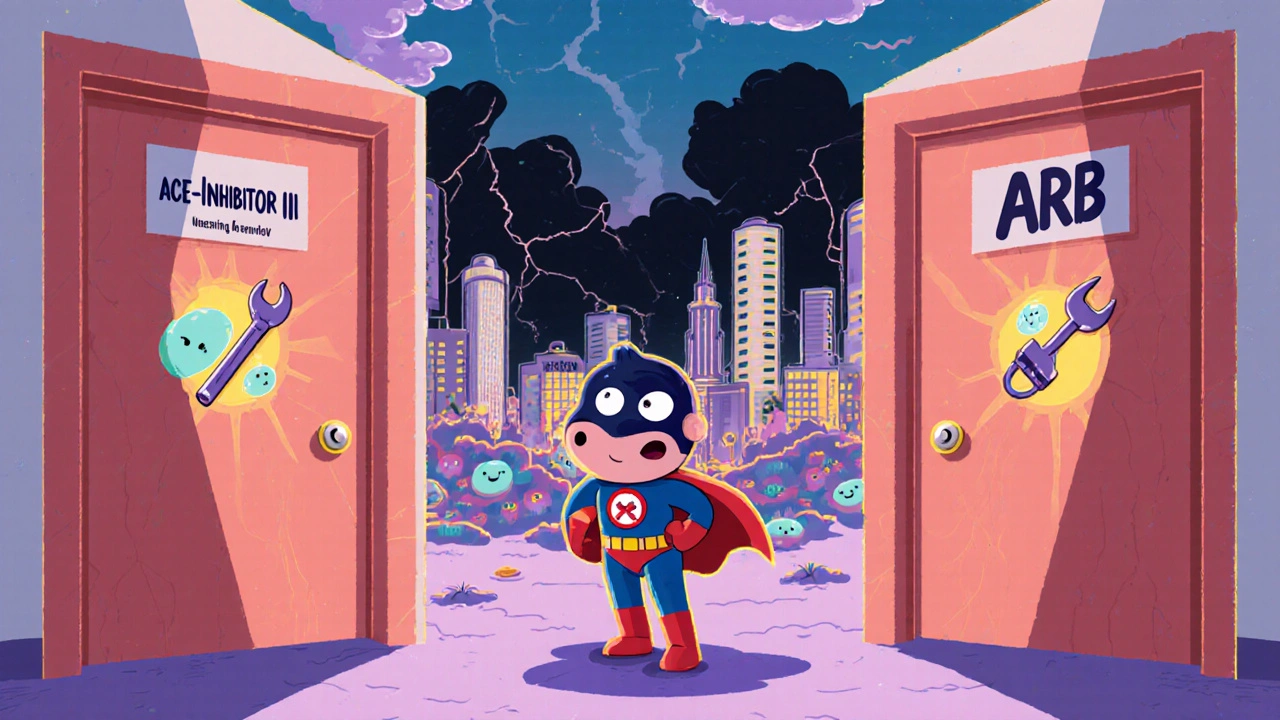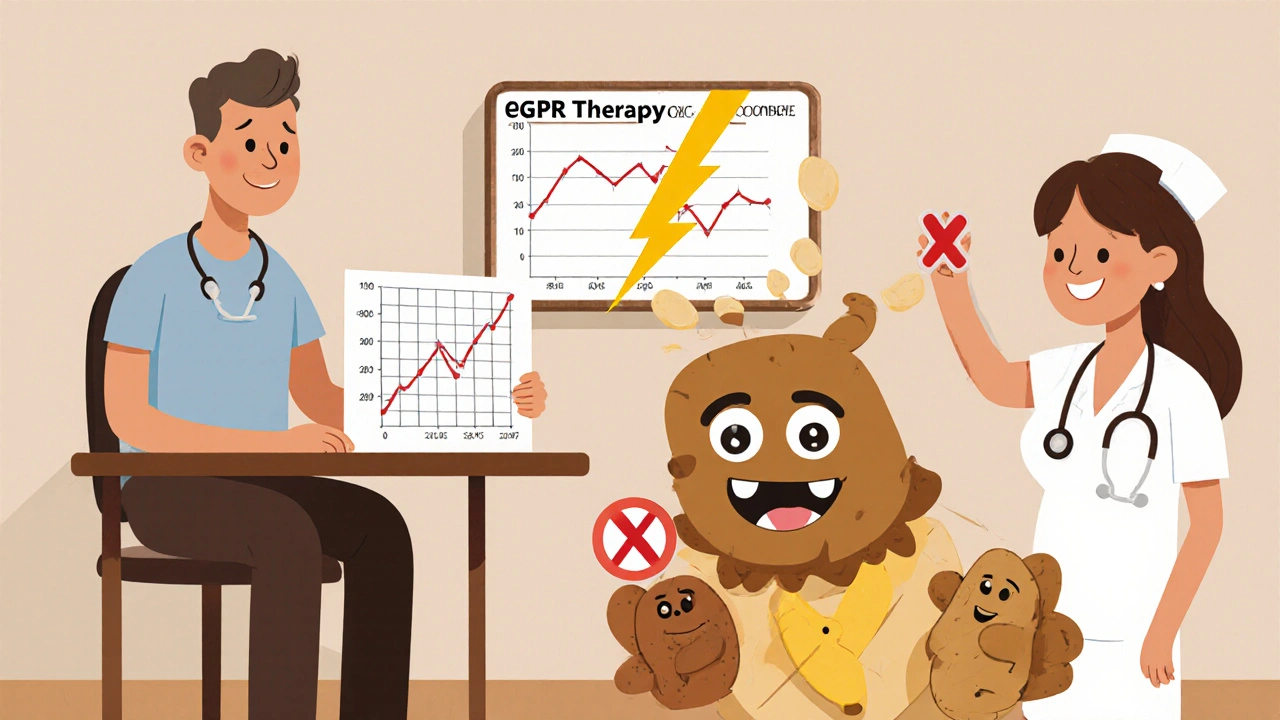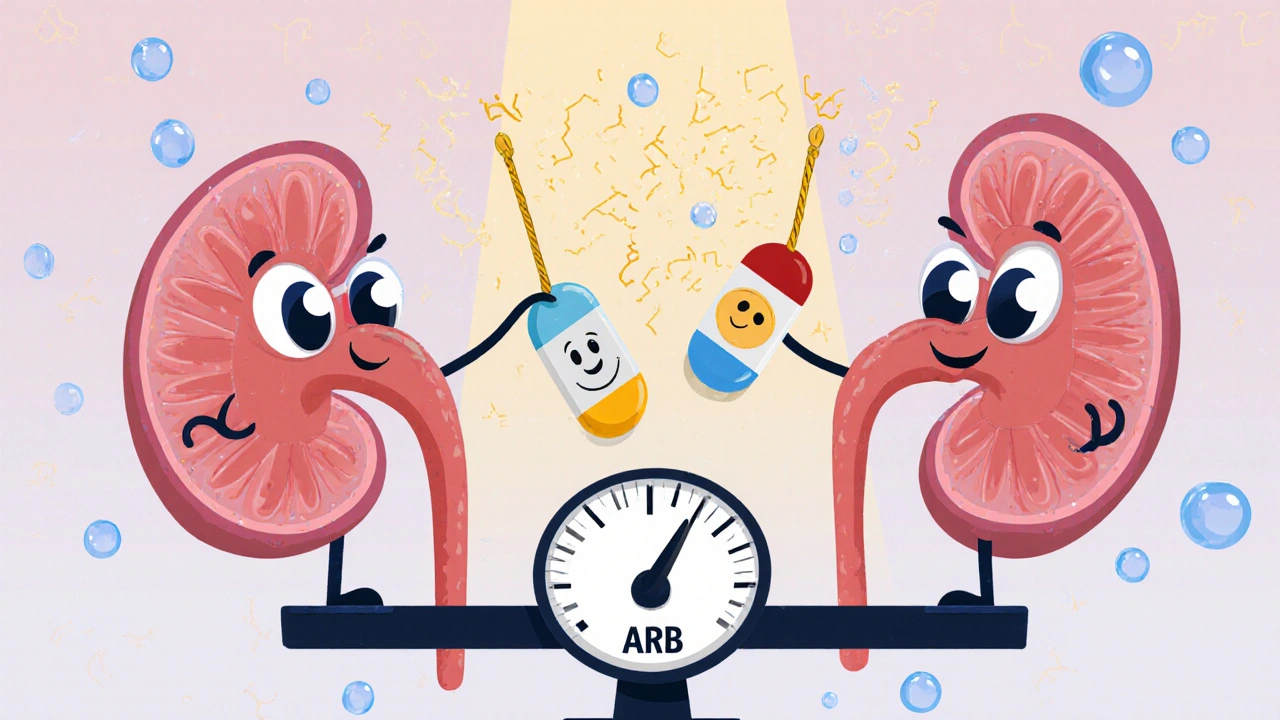When your kidneys are damaged, high blood pressure doesn’t just worsen your condition-it speeds up the damage. For people with chronic kidney disease (CKD), controlling blood pressure isn’t just about avoiding headaches or dizziness. It’s about stopping your kidneys from failing. And two classes of drugs-ACE inhibitors and ARBs-have become the backbone of this effort. They don’t just lower blood pressure. They protect your kidneys in ways other medications can’t.
Why Blood Pressure Matters in Kidney Disease
Your kidneys filter waste and extra fluid from your blood. They do this using tiny filters called glomeruli. When blood pressure stays high, those filters get crushed under pressure. Over time, they leak protein into your urine-a sign called proteinuria. That leak isn’t just a symptom. It’s a signal your kidneys are breaking down.
Studies show that for every 10 mmHg drop in systolic blood pressure, the risk of kidney failure drops by about 15%. But not all blood pressure drugs work the same. Beta-blockers or diuretics might bring numbers down, but they don’t stop the internal damage. ACE inhibitors and ARBs do. They target the root cause: the renin-angiotensin-aldosterone system (RAAS). This system, meant to regulate blood pressure, becomes overactive in kidney disease and literally squeezes your kidneys to death.
How ACE Inhibitors and ARBs Work
ACE inhibitors like lisinopril, enalapril, and benazepril block the enzyme that turns angiotensin I into angiotensin II. Angiotensin II is a powerful chemical that tightens blood vessels and raises pressure. By stopping its production, ACE inhibitors relax the arteries and reduce pressure inside the kidney’s filtering units.
ARBs-like losartan, valsartan, and irbesartan-do something similar but from a different angle. Instead of stopping angiotensin II from being made, they block its receptors. Think of it like locking the door so angiotensin II can’t get in. The result? Lower pressure, less protein leakage, and slower kidney damage.
Both classes reduce proteinuria by 30-50%. That’s not a small number. Reducing protein in urine is one of the strongest predictors of long-term kidney survival. In patients with diabetes or high blood pressure, using these drugs can slow kidney disease progression by 20-40%. That’s the difference between needing dialysis in 10 years versus 20.
Who Benefits the Most?
These drugs work best when you have protein in your urine. The higher the level-especially above 200 mg/g of albumin-to-creatinine ratio-the more you stand to gain. People with diabetic kidney disease, hypertensive nephropathy, or IgA nephropathy see the clearest benefits.
But here’s the surprising part: they help even in advanced kidney disease. For years, doctors avoided prescribing ACE inhibitors or ARBs when eGFR dropped below 30 mL/min. The fear? That they’d cause sudden kidney failure or dangerous spikes in potassium. But a 2024 study of 1,237 patients with stage IV or V CKD showed something different. Those who kept taking their ACE inhibitor or ARB had a 34% lower risk of reaching kidney failure requiring dialysis or transplant. Their kidneys didn’t crash-they held on longer.
The Kidney Disease: Improving Global Outcomes (KDIGO) 2023 guidelines now say: if your eGFR is above 15 and your potassium is under 5.0 mmol/L, keep taking them. Don’t stop just because your kidneys are weak. That’s a myth that’s costing people time.

ACE Inhibitors vs. ARBs: What’s the Difference?
Both work equally well at lowering blood pressure and protecting kidneys. But they differ in side effects.
ACE inhibitors cause a dry, nagging cough in 5-20% of users. It’s not dangerous, but it’s annoying enough that many people quit. That cough is caused by a buildup of bradykinin-a side effect of blocking ACE. ARBs don’t do that. So if you can’t tolerate a cough, switching to an ARB often fixes it.
There’s also a rare but serious risk with ACE inhibitors: angioedema. That’s swelling of the face, lips, or throat. It happens in about 1 in 500 to 1 in 1,000 people. If it happens, you stop the drug immediately. ARBs have a much lower risk-less than 0.05%.
When it comes to effectiveness, they’re nearly identical. One 2023 review found no difference in kidney protection between the two. So the choice often comes down to side effects, cost, and what your doctor’s used to prescribing.
The Dangerous Myth: Dual Therapy
Some doctors used to think combining an ACE inhibitor and an ARB would give extra protection. After all, if one blocks production and the other blocks receptors, wouldn’t two be better?
The answer is no. The Veterans Affairs Nephropathy Trial showed that dual therapy reduced proteinuria by an extra 15-20%. But it also doubled the risk of acute kidney injury and increased hyperkalemia (high potassium) by 50%. That’s not a trade-off worth making.
Current guidelines strongly advise against using both together. The small extra benefit in protein reduction is wiped out by the spike in danger. Stick to one. Maximize the dose. Then add other blood pressure meds if needed.

Monitoring: What You Need to Watch For
These drugs are safe-but only if you monitor them. Before starting, your doctor should check:
- Estimated glomerular filtration rate (eGFR)
- Serum potassium
- Urine albumin-to-creatinine ratio (UACR)
Then, within 1-2 weeks after starting or increasing the dose, check them again. A small drop in eGFR-up to 20-30%-is normal. It means the drugs are working inside your kidneys, reducing pressure. But if eGFR drops more than 30%, or potassium goes above 5.5 mmol/L, you need to pause and reassess.
Hyperkalemia is the biggest reason people stop these drugs. Potassium builds up because the kidneys can’t excrete it well. But it’s manageable. Avoid salt substitutes (they’re full of potassium), limit high-potassium foods like bananas, oranges, potatoes, and spinach, and don’t take potassium supplements unless prescribed.
Most patients can stay on these drugs for years with monthly checks. A Reddit thread from March 2024 shared stories of people with stage 4 CKD on lisinopril for over 5 years-stable eGFR, normal potassium, no dialysis.
Why So Many People Aren’t Taking Them
Despite overwhelming evidence, only 58% of patients with advanced CKD are on ACE inhibitors or ARBs. In early CKD, it’s 82%. That gap isn’t due to lack of guidelines. It’s due to fear.
Doctors worry about kidney injury. Patients worry about side effects. But the real danger isn’t the drug-it’s not taking it. A 2023 review by Dr. Rajiv Agarwal from Indiana University put it bluntly: “Fear of adverse events has led to therapeutic nihilism in advanced CKD, denying patients proven benefits without evidence of harm.”
These drugs are underused because they’re misunderstood. They’re not risky. They’re life-preserving. The key isn’t avoiding them-it’s managing them right.
What’s Next? The Future of Kidney Protection
Scientists are already looking beyond ACE inhibitors and ARBs. A new class called ARNIs-angiotensin receptor-neprilysin inhibitors-is showing promise. Sacubitril/valsartan, used in heart failure, reduced kidney function decline by 22% compared to enalapril in a 2024 trial. It’s not yet approved for kidney disease alone, but it’s a sign of where things are headed.
For now, though, ACE inhibitors and ARBs remain the gold standard. They’ve been around for decades. They’re cheap. They’re proven. And they work.
If you have kidney disease and high blood pressure, ask your doctor: “Am I on the right blood pressure medicine to protect my kidneys?” If you’re not on an ACE inhibitor or ARB, find out why. Don’t accept a no without a clear reason backed by data.
Your kidneys don’t need perfection. They need protection. And these drugs are the best tool we have to give it to them.
Can ACE inhibitors or ARBs cause kidney failure?
No, they don’t cause kidney failure. In fact, they slow it down. A small, temporary drop in kidney function (up to 30%) is normal when you start these drugs-it means they’re reducing pressure inside the kidneys. But if eGFR drops more than 30% or potassium rises above 5.5 mmol/L, your doctor may adjust the dose. Stopping them because of fear often leads to faster kidney decline.
Are ARBs better than ACE inhibitors for kidney disease?
They’re equally effective at protecting kidneys and lowering blood pressure. The main difference is side effects. ACE inhibitors cause a dry cough in 5-20% of people and carry a small risk of angioedema. ARBs rarely cause cough and have a much lower risk of swelling. If you can’t tolerate an ACE inhibitor, switching to an ARB is a safe and effective move.
Should I stop ACE inhibitors or ARBs if I have stage 4 or 5 kidney disease?
No, unless your potassium is above 5.5 mmol/L or your eGFR has dropped below 15 mL/min. New evidence from 2024 shows patients with advanced CKD who continued these drugs had a 34% lower risk of needing dialysis. Stopping them doesn’t protect your kidneys-it removes their best defense. Follow your doctor’s monitoring plan, but don’t stop without good reason.
Can I take both an ACE inhibitor and an ARB together?
No. Combining them increases proteinuria reduction slightly, but it also doubles your risk of acute kidney injury and raises potassium to dangerous levels. Major guidelines, including KDIGO and the American Heart Association, strongly advise against dual therapy. Use one or the other, and maximize the dose before adding other blood pressure medications.
How long does it take to see kidney protection from these drugs?
You won’t feel better right away. But within 3-6 months, you should see a drop in protein in your urine, which is the best early sign of kidney protection. Long-term benefits-like delaying dialysis-take years to show up. The goal isn’t to feel different. It’s to prevent the worst outcomes. Consistency matters more than speed.
What foods should I avoid while taking ACE inhibitors or ARBs?
Avoid salt substitutes (they’re high in potassium), limit high-potassium foods like bananas, oranges, potatoes, tomatoes, spinach, and beans. Don’t take potassium supplements unless your doctor prescribes them. Also, avoid NSAIDs like ibuprofen or naproxen-they can reduce kidney blood flow and make these drugs less safe. Always check with your doctor before taking any new supplement or OTC painkiller.


Nosipho Mbambo
Okay, but like... why do I have to take yet another pill? I’m already on three for my BP, one for diabetes, and a statin. And now I gotta worry about potassium and eGFR and... ugh. I just want to feel normal. Also, why does my doctor keep increasing the dose? I’m not even sure it’s helping.
Katie Magnus
Let me get this straight-you’re telling me a drug that gives me a cough and makes me feel like I’m dying of thirst is somehow ‘protecting’ my kidneys? That’s not protection, that’s emotional abuse. Also, ARBs? Sounds like a brand of yoga mats. I’m switching to celery juice and crystals. My kidneys thank me.
King Over
ACE and ARBs work. Been on lisinopril for 8 years. eGFR stable. Potassium fine. No cough. Doc says keep going. That’s it.
Johannah Lavin
Y’all I just want to say-this post made me cry 😭 I’ve been on losartan since my diagnosis 5 years ago and I was SO scared to keep taking it when my eGFR dropped to 28. But my nephrologist said ‘trust the science, not the fear’ and I did. And guess what? I’m still here. No dialysis. Still walking my dog every morning. You’re not broken. You’re just being protected. ❤️🫂
Ravinder Singh
Bro, this is gold. ACE inhibitors and ARBs are the unsung heroes of nephrology. I’ve seen patients with stage 4 CKD on these meds for over a decade-no dialysis, no hospitalizations, just steady, quiet survival. The real tragedy? Doctors stopping them out of fear. You don’t turn off the fire alarm because the smoke alarm went off. You fix the smoke. Same here. Monitor potassium, adjust diet, don’t panic. And please-no dual therapy. That’s like putting two seatbelts on one person and calling it ‘extra safety.’ Nope. One’s enough. 🙌
Russ Bergeman
Wait, so you’re saying if I stop these drugs, my kidneys will fail faster? But what if they’re already failing? Isn’t that like giving oxygen to a corpse? Also, why do you keep saying ‘proteinuria’? Can’t you just say ‘protein in pee’? And also-why do I have to avoid bananas? I love bananas. This is all just a scam to sell more lab tests.
Dana Oralkhan
I just want to add-this isn’t just about drugs. It’s about being heard. I was told to stop my ARB because my eGFR dropped, and I believed them. Within 6 months, I was on dialysis. I wish someone had told me what this post says. Please, if you’re reading this and you’re scared-talk to a nephrologist, not just your GP. There’s hope. And you’re not alone.
Jeremy Samuel
ace inhibitors? more like ace in the hole. i read this whole thing and still think they’re just putting a bandaid on a bullet wound. also why is everyone so obsessed with protein in urine? i have a cat, she pees on the rug, i don’t care. same thing. just let me eat my doritos.